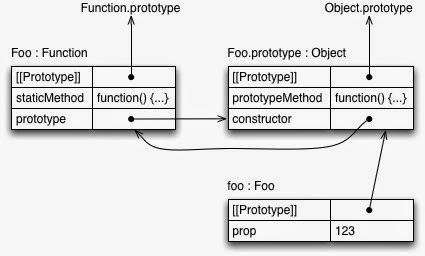javascript ES 6 class 详解
2016-07-01 10:57
525 查看
javascript ES 6 class 详解
Introduction
上篇文章大致介绍了一些ES6的特性,以及如何在低版本浏览器中使用它们。本文是对class的详解。译自Axel Rauschmayer的Classes in ECMAScript 6
另外,如果只是想测试ES6,可以到这个网站。
Overview
借助class 我们可以写出这样的代码:class Point {
constructor(x, y) {
this.x = x;
this.y = y;
}
toString() {
return '(' + this.x + ', ' + this.y + ')';
}
}
class ColorPoint extends Point {
constructor(x, y, color) {
super(x, y);
this.color = color;
}
toString() {
return super.toString() + ' in ' + this.color;
}
}
let cp = new ColorPoint(25, 8, 'green');
cp.toString(); // '(25, 8) in green'
console.log(cp instanceof ColorPoint); // true
console.log(cp instanceof Point); // true
Base classes
我们可以定义如下的class:class Point {
constructor(x, y) {
this.x = x;
this.y = y;
}
toString() {
return '(' + this.x + ', ' + this.y + ')';
}
}我们可以像使用ES5标准中的constructor一样实例化class
> var p = new Point(25, 8); > p.toString() '(25, 8)'
实际上,class还是用function实现的,并没有为js创造一个全新的class体系。
> typeof Point 'function'
但是,与function相比,它是不能直接调用的,也就是说必须得new出来
> Point() TypeError: Classes can’t be function-called
另外,它不会像function一样会被hoisted(原因是语义阶段无法解析到extends的内容)
foo(); // works, because `foo` is hoisted
function foo() {}
new Foo(); // ReferenceError
class Foo {}function functionThatUsesBar() {
new Bar();
}
functionThatUsesBar(); // ReferenceError
class Bar {}
functionThatUsesBar(); // OK与函数一样,class的定义表达式也有两种,声明形式、表达式形式。之前用的都是声明形式,以下是表达式式的:
const MyClass = class Me {
getClassName() {
return Me.name;
}
};
let inst = new MyClass();
console.log(inst.getClassName()); // Me
console.log(Me.name); // ReferenceError: Me is not defined
Inside the body of a class definition
class定义体是只能包含方法,不能包含属性的(标准定义组织认为原型链中不应包含属性),属性被写在constructor中。以下是三种会用到的方法(constructor 、static method、 prototype method):class Foo {
constructor(prop) {
this.prop = prop;
}
static staticMethod() {
return 'classy';
}
prototypeMethod() {
return 'prototypical';
}
}
let foo = new Foo(123);如下图([[Prototype]]代表着继承关系)当对象被new出来,拿的是Foo.prototype : Object分支,从而可以调prototype method

constructor,这个方法本身,代表了class
> Foo === Foo.prototype.constructor true
constructor有时被称为类构造器。相较于ES5,它可以调用父类的constructor(使用super())。
static methods。它们归属于类本身。
> typeof Foo.staticMethod 'function' > Foo.staticMethod() 'classy'
关于Getters and setters,它们的语法如下:
class MyClass {
get prop() {
return 'getter';
}
set prop(value) {
console.log('setter: '+value);
}
}
> let inst = new MyClass();
> inst.prop = 123;
setter: 123
> inst.prop
'getter'方法名是可以动态生成的
class Foo() {
myMethod() {}
}
class Foo() {
['my'+'Method']() {}
}
const m = 'myMethod';
class Foo() {
[m]() {}
}增加了迭代器的支持,需要给方法前面加一个*
class IterableArguments {
constructor(...args) {
this.args = args;
}
* [Symbol.iterator]() {
for (let arg of this.args) {
yield arg;
}
}
}
for (let x of new IterableArguments('hello', 'world')) {
console.log(x);
}
// Output:
// hello
// world
Subclassing
通过extends,我们可以继承其它实现constructor的函数或对象。需要注意一下,constructor与非constructor调用父类方法的途径是不同的。class Point {
constructor(x, y) {
this.x = x;
this.y = y;
}
toString() {
return '(' + this.x + ', ' + this.y + ')';
}
}
class ColorPoint extends Point {
constructor(x, y, color) {
super(x, y); // (A)
this.color = color;
}
toString() {
return super.toString() + ' in ' + this.color; // (B)
}
}
> let cp = new ColorPoint(25, 8, 'green');
> cp.toString()
'(25, 8) in green'
> cp instanceof ColorPoint
true
> cp instanceof Point
true子类的原型就是它的父类
> Object.getPrototypeOf(ColorPoint) === Point true
所以,static method也被继承了
class Foo {
static classMethod() {
return 'hello';
}
}
class Bar extends Foo {
}
Bar.classMethod(); // 'hello'static方法也是支持调用父类的。
class Foo {
static classMethod() {
return 'hello';
}
}
class Bar extends Foo {
static classMethod() {
return super.classMethod() + ', too';
}
}
Bar.classMethod(); // 'hello, too'关于子类中使用构造器,需要注意的是,调用this之前,需要调用super()
class Foo {}
class Bar extends Foo {
constructor(num) {
let tmp = num * 2; // OK
this.num = num; // ReferenceError
super();
this.num = num; // OK
}
}constructors是可以被显示覆盖(override)的。
class Foo {
constructor() {
return Object.create(null);
}
}
console.log(new Foo() instanceof Foo); // false如果基类中不显示定义constructor,引擎会生成如下代码
constructor() {}对于子类
constructor(...args) {
super(...args);
}
The details of classes
类名不能为eval 或者 arguments,不能有重复的类名,constructor不支持getter,setter。classes不能像函数一样调用。
原型方法不能用作构造器:
class C {
m() {}
}
new C.prototype.m(); // TypeError
The details of subclassing
ES 6中,子类的使用方法如下:class Point {
constructor(x, y) {
this.x = x;
this.y = y;
}
···
}
class ColorPoint extends Point {
constructor(x, y, color) {
super(x, y);
this.color = color;
}
···
}
let cp = new ColorPoint(25, 8, 'green');原型链实现:
> const getProto = Object.getPrototypeOf.bind(Object);
> getProto(Point) === Function.prototype
true
> getProto(function () {}) === Function.prototype
true
> getProto(Point.prototype) === Object.prototype
true
> getProto({}) === Object.prototype
true原文链接:http://www.cnblogs.com/E-WALKER/p/4796278.html
相关文章推荐
- 再次理解js中的call函数
- JavaScript中有关一个数组中最大值和最小值及它们的下表的输出的解决办法
- perl 异步请求和JS对比
- perl 异步请求和JS对比
- perl 异步请求和JS对比
- 解决json显示日期带T的问题。
- js实现访客人数统计
- jsonp跨域调用代码实例
- js代码定义类代码的领悟
- js-QQ三方登陆
- JS获取地址栏参数的方法
- js里面添加onclick传递参数符号问题
- js实现倒计时
- uploadify.js
- js控制video的播放和暂停
- Javascript异步编程的4种方法
- js合计
- JavaScript中Number类型,Number,parseInt转换函数特殊情况总结
- js获取日期时间
- JavaScript中的函数
